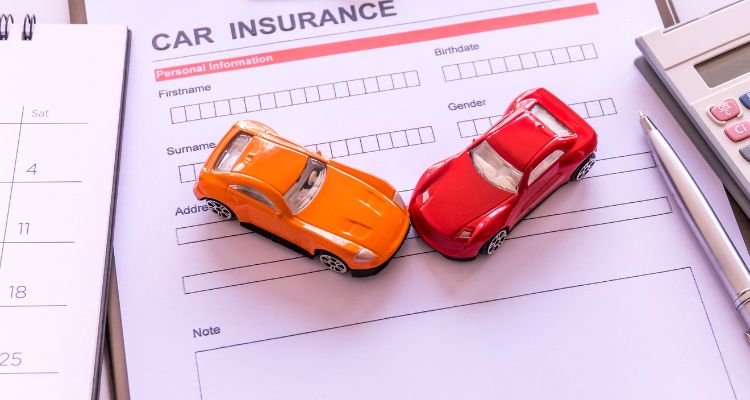Car insurance: guide to choosing the right policy for you
Comprehensive guide on choosing the right car insurance: coverage types, cost-saving tips, and essential factors for informed decisions.

Every driver faces the challenge of selecting an appropriate car insurance policy. With numerous options available, it is easy to feel overwhelmed. However, understanding the basics makes the process simpler and more straightforward. In this guide, we explore what car insurance entails, discuss the different types of policies, and share tips on reducing costs while maintaining quality cover.
What is car insurance?
Car insurance is a contract between you and an insurance company. In exchange for paying a premium, the insurer promises to cover losses in the event of an accident or theft. This cover protects you from financial hardship when unexpected incidents occur. Car insurance not only covers damages to your vehicle but also protects you from liability claims if you are responsible for injuries or property damage.
Insurance policies vary in scope and detail. Some policies cover only third-party liability, while others provide comprehensive protection that includes damage to your own vehicle, personal injuries, and additional benefits such as roadside assistance.
Why car insurance is essential
Car insurance is mandatory in most countries, including the United Kingdom. It offers several benefits:
- Legal Compliance: Driving without insurance is illegal and can result in fines, points on your licence, or even prosecution.
- Financial Security: Accidents can be expensive. Insurance protects you against costly repairs, legal claims, and unforeseen expenses.
- Peace Of Mind: With the right cover, you can drive knowing that you are protected against risks and uncertainties.
For more details on legal requirements, the official UK Government website provides updated guidance on car insurance regulations. Additionally, trusted resources like MoneySavingExpert offer practical advice to help you understand your options.
Types of car insurance policies
Choosing the right type of car insurance depends on your individual needs, driving habits, and the condition of your vehicle. The main types of car insurance policies include:
Third Party Only
Third Party Only policies cover damage to other people’s property or injuries to other drivers and pedestrians. They do not cover damage to your own vehicle. This is the minimum level of cover required by law.
Third Party, Fire And Theft
This type of policy extends the coverage of Third Party Only by including protection against fire damage and theft. It is an ideal option if you want more than basic cover but do not need comprehensive insurance.
Comprehensive
Comprehensive car insurance provides the highest level of cover. It includes third party cover and protects your own vehicle against damage, theft, and other risks. It also often covers additional benefits such as legal expenses and personal accident cover. Although it is more expensive, comprehensive cover offers the greatest peace of mind.
For understanding the legal requirements for car insurance in the UK, see the government’s official website. It provides up-to-date information about car insurance policies and regulations.
How to choose the right policy
Selecting the right car insurance policy involves careful consideration of several factors. Here are some practical steps to guide you:
- Assess Your Needs: Consider how often you drive, where you live, and the value of your vehicle. If you live in an urban area with high traffic, a comprehensive policy might offer better protection.
- Compare Policies: Use online comparison tools to assess different providers. Make sure to compare the benefits and premiums of each policy.
- Read The Fine Print: It is important to understand the terms and conditions. Check for exclusions, deductibles, and any additional fees.
- Consider Additional Benefits: Some policies offer extras like breakdown cover, no-claims bonus protection, and legal assistance. Evaluate if these are important for you.
- Seek Expert Advice: If you are unsure, it can be helpful to consult with an insurance broker or read expert reviews on websites such as Which?.
Factors that influence your premium
Many factors influence the cost of your car insurance premium. Understanding these can help you manage and possibly lower your expenses. The key factors include:
Driver’s Age And Experience
Young or inexperienced drivers are generally considered high risk. This factor may lead to higher premiums. As your driving experience increases, you might be eligible for lower rates.
Vehicle Type
The make and model of your car significantly impact your premium. High-performance or luxury vehicles often cost more to insure due to the increased cost of repairs or replacement. Conversely, cars with advanced safety features might attract lower premiums.
Driving History
A clean driving record with no claims or accidents is a strong indicator of a low-risk driver. Conversely, past incidents can result in higher premiums. Many insurers offer discounts for drivers with a history of safe driving.
Location
Where you live can affect your premium. Urban areas typically see higher rates due to the increased likelihood of accidents and theft. Rural areas may offer lower premiums but can also have limited insurance options.
Annual Mileage
The more you drive, the higher the risk of an accident. Insurers often consider your annual mileage when determining your premium. Reducing your mileage or using your car less frequently may result in lower rates.
Security Features
Cars equipped with modern security systems, such as alarms and immobilisers, are less likely to be stolen. Installing these features can result in a discount on your premium.
For additional insights on how these factors affect your premium, Confused.com provides detailed information and tips.
Practical tips to lower your car insurance premium
Reducing your premium without sacrificing essential cover is a goal for many drivers. Here are some practical tips:
- Increase Your Excess: A higher voluntary excess can lower your premium. However, ensure you can afford the excess in the event of a claim.
- Build A No-Claims Bonus: Avoiding claims can earn you discounts over time. Many insurers offer substantial savings for drivers with several years of claim-free driving.
- Consider Telematics: Some insurers offer telematics-based policies that monitor your driving habits. Safe drivers can benefit from lower premiums through this approach.
- Secure Your Vehicle: Installing security devices can help reduce the risk of theft and vandalism. Many providers offer discounts for vehicles with enhanced security measures.
- Review Your Policy Annually: Regularly reviewing your cover can help you take advantage of new offers and discounts. Comparing providers each year can ensure you are getting the best deal.
Common misconceptions about car insurance
There are several misconceptions about car insurance that can lead to confusion. Clearing up these misunderstandings can help you make informed decisions.
Misconception 1: Cheaper Is Always Better
Many drivers assume that the cheapest policy provides sufficient cover. However, a low premium might mean limited benefits or higher excesses. It is crucial to balance cost with the level of protection offered.
Misconception 2: Comprehensive Policies Are Unnecessary
Some drivers believe that if their car is older, comprehensive insurance is not needed. Even older vehicles can benefit from comprehensive cover, especially if they hold personal or historical value. Additionally, comprehensive policies often come with extras that offer greater peace of mind.
Misconception 3: Adding Extra Drivers Will Lower The Premium
Adding extra drivers, even if they are not regular users of the car, can increase the premium. Insurers often consider the risk associated with every driver on the policy. It is important to list only those who use the vehicle regularly.
The impact of driving behaviour on your policy
Your driving habits can have a significant influence on your insurance costs. Safe and responsible driving leads to fewer claims and a better record, which in turn lowers your premium. Here are some ways to improve your driving behaviour:
- Practice Defensive Driving: Stay alert, anticipate potential hazards, and maintain a safe distance from other vehicles.
- Obey Traffic Laws: Adhering to speed limits and traffic regulations reduces the likelihood of accidents.
- Avoid Distracted Driving: Focus solely on the road, and avoid using mobile phones or engaging in other distracting activities while driving.
Adopting safe driving techniques not only reduces your risk of accidents but also contributes to lowering your insurance premiums over time.
How claims are processed
When an incident occurs, the claims process can be a critical factor in your overall experience with your insurer. Here is an overview of how claims are generally processed:
- Report The Incident: Contact your insurer as soon as possible after an accident or theft. Provide them with accurate details of the event.
- Assessment And Investigation: The insurer will assess the claim by gathering information, inspecting the damage, and determining liability.
- Approval And Settlement: Once the claim is approved, the insurer will provide compensation or arrange for repairs. The process timeline can vary depending on the complexity of the claim.
- Review And Feedback: After settlement, some insurers may ask for feedback to improve their service. This is a chance for you to share your experience.
Efficient claims processing is essential for customer satisfaction. To understand more about the claims process and what to expect, The AA offers detailed guides and customer reviews.
The future of car insurance
The car insurance industry continues to evolve, with technological advancements reshaping how policies are priced and managed. Innovations such as telematics, artificial intelligence, and real-time data analysis are changing the landscape of car insurance. These developments promise to offer more personalised policies, better risk assessment, and faster claims processing.
As insurers adopt new technologies, drivers can expect more dynamic pricing models and customised solutions that adapt to individual driving patterns. This shift not only benefits safe drivers but also encourages improvements in overall road safety. The evolution of car insurance is an exciting development, promising to offer greater transparency and efficiency in the long term.
How to get the best deal on car insurance
Finding the best deal on car insurance requires careful research and comparison. Here are some steps to guide you in your search:
- Gather Multiple Quotes: Request quotes from several insurers to understand the range of available prices and cover options.
- Use Comparison Websites: Online comparison sites aggregate data from different providers, making it easier to compare policies side by side.
- Check Customer Reviews: Reading feedback from current customers can reveal insights into an insurer’s reliability and service quality.
- Negotiate Terms: In some cases, you might be able to negotiate a better rate or ask for discounts if you have multiple policies with the same provider.
- Review Policy Details Carefully: Ensure that the cheapest policy does not come with hidden costs or insufficient cover.
Remember that the lowest premium does not always equate to the best value. Focus on the balance between cost and coverage. For more detailed advice, you can visit Which? Car Insurance for expert reviews and comparisons.
Additional resources and guidance
For those looking to delve deeper into car insurance, several external resources can offer further clarity:
- The UK Government website provides official information on legal requirements.
- Money Advice Service offers consumer advice on selecting and managing policies.
- Confused.com remains a reliable resource for comparing different providers and policies.
- The AA provides practical guides and customer testimonials that can help inform your decision.
Additionally, for more insurance-related topics, please visit this page on our website. It provides a wealth of information that can help you navigate the insurance market with confidence.
Frequently asked questions
What factors can lower my car insurance premium?
Increasing your excess, maintaining a no-claims bonus, installing security features, and using telematics are effective ways to reduce your premium. A clear driving record and limited mileage also contribute to lower costs.
Do I need comprehensive cover if my car is old?
Even older cars benefit from comprehensive cover if you value additional protection against theft, vandalism, or accidental damage. The decision depends on the vehicle’s market value and your personal financial risk tolerance.
How does telematics work in car insurance?
Telematics-based policies monitor your driving habits using a device installed in your vehicle or an app on your smartphone. This data helps insurers assess risk more accurately. Safe drivers can enjoy significant discounts based on real-time performance.
Can adding a second driver affect my premium?
Yes, including additional drivers can increase your premium, especially if they are considered high risk. It is advisable to add only those who regularly use the vehicle.
How often should I review my car insurance policy?
Reviewing your policy annually is a good practice. Market conditions, personal circumstances, and available discounts can change over time, making it worthwhile to reassess your cover regularly.
Choosing the right car insurance policy is a process that demands attention to detail and an understanding of your personal requirements. By knowing the different types of coverage, comparing policies, and considering factors that affect premiums, you can make an informed decision. Car insurance is not just a legal formality; it is a crucial investment in your financial security and peace of mind.
This guide has covered the essentials—from understanding policy types and factors influencing premiums to practical tips for lowering costs and navigating the claims process. With the ever-evolving landscape of car insurance, staying informed is key. Empower yourself with knowledge and use the available resources to secure the best possible cover for your vehicle.
For further insights, always refer to reputable sources and continue learning about changes in the insurance market. Your proactive approach today can lead to significant savings and greater protection in the future.
By following these guidelines and regularly reviewing your cover, you can ensure that your car insurance policy remains a valuable and effective safety net on the road.




